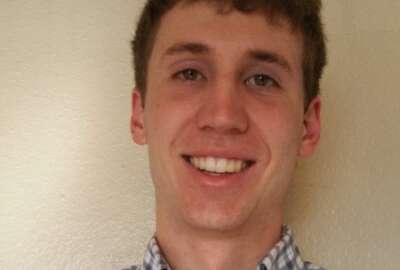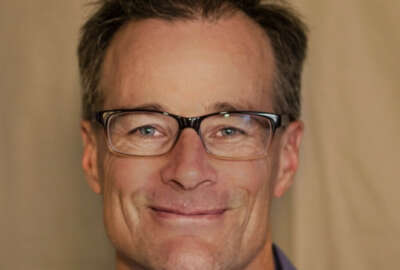Air Force Research Lab creates a new approach to situational awareness in space
You may not wake up thinking about Cislunar-space situational awareness, but people at the Air Force Research Laboratories. In fact, AFRL has had two programs for...
You may not wake up thinking about Cislunar-space situational awareness, but people at the Air Force Research Laboratories. In fact, AFRL has had two programs for such awareness. Two programs they have brought together. The resulting program is called the Oracle family of systems. To find out more, the Federal Drive with Tom Temin talked with two of the project leaders: Mission Lead Jaime Stearns and Investigator James Frith.
Interview Transcript:
Tom Temin All right, so let’s begin at the beginning here. Cislunar-space situational awareness. It’s a mouthful. What is it exactly?
Jaime Stearns Sure. So let’s break that term down a little bit. We’ll start with cislunar. Technically that means the area between the Earth and the moon. But a bunch of us have started using it in a much more general sense. And I think that was codified in a national strategy that was actually released in November of 2022 that talks about cislunar-space as the area all the way out to the moon and a little bit beyond that is to these points of stability called Lagrange points. And there’s one on the far side of the moon, about 65,000km further than the moon. And so cislunar- space goes all the way out there. And the way that we talk about it, we usually mean it to start not quite at the Earth, but beyond a geosynchronous orbit. So a little bit beyond the area where the Department of Defense in particular is used to operating. We really use cislunar to mean that whole area beyond where we’re used to operating to the other side of the moon. And all of that in a full sphere that rotates as the moon rotates around the Earth.
Tom Temin In general, though, operations don’t go really much beyond that which can orbit the Earth itself. There’s nothing besides the moon that’s as far away as the moon.
Jaime Stearns There are a few satellites out there already. NASA is looking to send the Artemis missions out that way. Other countries and commercial operators are sending a fair amount of traffic all the way out to the moon. But in terms of Department of Defense operations, that has really just been at geosynchronous orbit and below historically. And that’s some of what the Air Force Research Lab is looking to expand here.
Tom Temin Ok. And you were going to continue with one more thought.
Jaime Stearns Yeah, I was going to define space situational awareness. That’s really just the process of keeping track of all of the objects in space. In its most general form, it means both natural objects and manmade objects. So satellites, our focus is largely on keeping track of satellites so that we understand where they’re at, we can make sure that they’re not going to run into each other. If anything goes wrong with one of them knowing where it’s at helps provide support to the operator of that satellite. And this is something that we have done traditionally, again in geosynchronous orbit and below. And we give that data away free to the world. We help owner operators operate in all of those traditional orbit regimes. And what we’re trying to do at AFRL is expand the capabilities to do that space situational awareness all the way out to the moon. So when the Artemis program goes back, we can help them understand where they are and make sure that nothing else is going to run into them.
Tom Temin And Dr. Frith, what form does this take? What kind of surveillance and listening devices or eyeballs are required here?
James Frith Well, it’s really not any different than what we’ve done in the past with Earth based telescopes or either optical or RF radio frequencies. The only real difference is adjusting the capabilities of the traditional telescopes to account for the greater distances, and the sort of increased complexity of the dynamics that happen when you start not only having to predict the motion of an object based on the gravity of the Earth, but also when both the Earth and the moon are affecting the satellite, which gets very complicated, very fast. This is called the three body problem. The gravitational dynamic is extremely complicated, and your ability to predict where these things are going to be over time.
Tom Temin Yeah, it sounds like three dimensional billiards.
James Frith You don’t really want them to run into each other. But yeah, it’s very much sitting on an ice rink, meaning that small forces can really make huge differences on the eventual location of the object over time.
Tom Temin And for this project, the Air Force has had some particular instruments in space for the cislunar research. Tell us about those and what’s up there now.
Jaime Stearns Most of our research now has been really more ground based than space based. We are in the process of developing two satellites to actually go out to cislunar-space and really begin pioneering how to do the space situational awareness mission out near the moon. So those are the two programs that we now call Oracle Mobility and Oracle Prime. And Oracle Mobility is really kind of the quick turn Pathfinder mission that initially began as a mobility experiment, and kind of through a convergent evolution process when we all realized how important cislunar- space was going to become. The Oracle M program office decided that they really wanted to focus on cislunar as the best demonstration of where they could explore the really high mobility that their satellite is going to have. And we also realized there was an opportunity to just get hands on experience. For our scientists, for our operators, or anyone in the Space Force who wants to be part of this program, to be able to actually learn to fly a satellite in cislunar-space. And that’s really what the Oracle M program is doing.
Tom Temin And does this instrument that will be launched, I guess, does it use optical viewing of what’s out there? Tell us more about what it actually can do. They can see things with optical and send back an image.
Jaime Stearns Exactly. It’ll have an optical telescope on it. So it will be taking pictures of the sky around it and hoping to capture any non star objects that are also in that field of view. Oracle M will be primarily focused on tracking objects that we already know are there. Just practicing doing that saying hey, we can go find the satellite that we know is out there, let’s go up, let’s take a picture of it. And when I say picture, not a result image or anything, these are just dots because they’re very, very, very far away. And be able to send that image back to the ground for further processing to say, yes, that is the satellite we thought it was, and then make that data available to the rest of the community for any research purposes they may have.
Tom Temin This is getting all more urgent, as more and more nations are able to launch things into space. And we’re not sure of what their intentions are all the time.
Jaime Stearns Well, I think there’s just going to be a lot of activity in cislunar-space, period. Just our own internal open source estimates. There’s going to be about 100 objects out there by 2026. If you include all the active satellites that we know are going from every country, from NASA, from commercial, and then anomalies happen, things go wrong. There’s always going to be an element of surprise where even if everyone is doing everything quite responsibly and nobody has any bad intentions, things still happen. So we just want to be able to observe all of these satellites and be prepared if we need to help people understand where objects are and make sure that we can not have any conjunctions or have a bad day in cislunar-space.
Tom Temin Sure. And let me ask you, James, when a dot is discovered, what does it take to understand that, hey, that dot wasn’t there yesterday, or it’s not just another star and this kind of thing. There must be a lot of processing that goes on to make sure that that is really what you think it is.
James Frith You’re actually poking at some of the more fundamental research that we’re going through AFRL, which is doing exactly that. So being able to build up a database of objects that already exists in cislunar-space, there are multiple NASA missions, multiple missions that were launched a long time ago, the 60s and 70s, exploring that space. And building up a catalog of things that we already know are out there making the catalog more accurate. And then, if we observe a new object that isn’t within the catalog to update the catalog as best we can, we can share that with the community, make sure that everyone knows what’s out there, and they can move out of the way as needed if that’s an issue. But truly, the dynamics of this environment is complicated, working sort of in the realm of chaos theory, meaning that as you increase the amount of time from an observation, you actually get unpredictable results in the future. So taking sort of basic PhD level research and turn it into a unified capability is one of our research efforts here.
Tom Temin Yeah. So a lot of science has come to bear on this. It sounds like.
James Frith Yeah. So there are two main thrusts. One is the that dynamical problem, which is increasing our accuracy and how we can predict these objects location over time. And the other big piece of that is the technology needed in order to produce data to actually observe the objects, which there are certain situations where that’s truly impossible from the Earth itself, which is why we need a space based component for cislunar SSA.
Tom Temin And I’m getting a little whiff of artificial intelligence in here.
James Frith We’re starting with just, biological intelligence first. And then there’s certainly, that’s one tool in the potential toolbox for us to use. But again, that’s not necessarily, going to solve everything.
Tom Temin And the fact that this is all happening at the Air Force Research Laboratory and not at, say, Space Force, which is supposed to have the operational ownership of the space domain. Sounds like we’re in the early stages of understanding what goes on up there and how to figure out how we can observe it. Fair to say?
Jaime Stearns That’s a perfect description. James and I both do officially work for the Space Force aligned under Air Force Research Lab. And so, yeah, the main goals of these programs and all the research that James discussed, really, is to help any future programs that are official and operationally run out of the Space Force to understand, not even just what do we build, but even understand the basic requirements. It’s, as James said, a very complicated space. And we want to help understand how you really do this mission and be able to define those requirements.
Tom Temin And have we found anything out there yet?
James Frith Yeah. So there have been dozens of launches over the last year or two to this region, which is proof that this is an area that we need to focus on as a nation in terms of making sure that we can, track these objects. So Artemis one launched a little while back and deployed ten CubeSats, which are now within that region. So tracking them has been challenging. The Luna-25 was launched recently. There is a Korean launch called Cape Yellow. There have been up to about a dozen or more satellites have been launched in cislunar-space in the last couple of years, and these have been very useful test objects to work on the dynamic problem that we’re discussing. Some of these have been observed, some of these haven’t. But we’re testing out tools, techniques all the time.
Jaime Stearns There’s another interesting aspect of this too, of historical launches. So just during the course of our research and trying to build out how you would build a catalog for cislunar-space. We’ve come across objects that were launched in the 60s, like rocket bodies from some of those early missions that have kind of been rediscovered and put back into some of our catalogs. So we’re kind of practicing that discovery phase as well, with things that were launched a long, long time ago.
Copyright © 2025 Federal News Network. All rights reserved. This website is not intended for users located within the European Economic Area.
Tom Temin is host of the Federal Drive and has been providing insight on federal technology and management issues for more than 30 years.
Follow @tteminWFED






